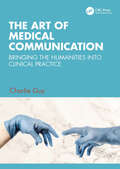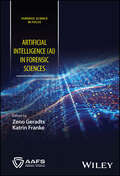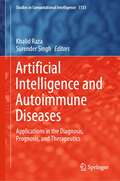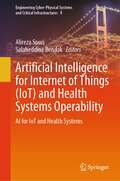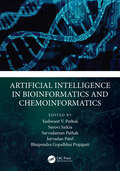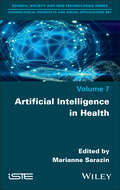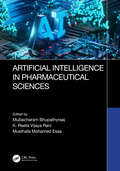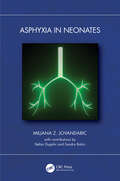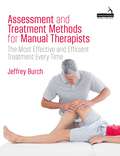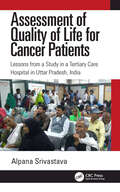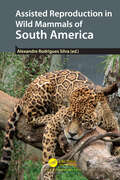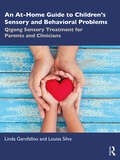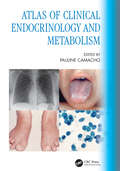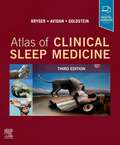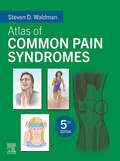- Table View
- List View
The Art of Medical Communication: Bringing the Humanities into Clinical Practice
by Charlie GuyThe field of medical humanities is growing rapidly and offers many valuable insights for medical education generally and for enhancing and improving communication specifically. Through practical and thought-provoking examples, this innovative new text demonstrates how engaging with the arts and humanities can benefit the work of doctors and make them better, more effective practitioners with a focus on achieving this through better communication and by stimulating self-reflection. Key features: Utilises modern and familiar examples, including case studies, to illustrate and explore language and communication skill deployment in a variety of given scenarios Reflects the increasing use of online consultation and the associated importance of ensuring effective communication in virtual settings Describes several models for reflective practice Supported by a selection of eResources to enhance reader experience and understanding; visit www.routledge.com/9781032272726 This new book is written specifically for medical students, junior doctors and medical educators looking to develop or teach communication skills. It will instil and support the background understanding of the role, need and ongoing requirement for humanities engagement in self-development and reflection to enhance and improve the experience of both the practitioner and the patient.
The Art of Medical Communication: Bringing the Humanities into Clinical Practice
by Charlie GuyThe field of medical humanities is growing rapidly and offers many valuable insights for medical education generally and for enhancing and improving communication specifically. Through practical and thought-provoking examples, this innovative new text demonstrates how engaging with the arts and humanities can benefit the work of doctors and make them better, more effective practitioners with a focus on achieving this through better communication and by stimulating self-reflection. Key features: Utilises modern and familiar examples, including case studies, to illustrate and explore language and communication skill deployment in a variety of given scenarios Reflects the increasing use of online consultation and the associated importance of ensuring effective communication in virtual settings Describes several models for reflective practice Supported by a selection of eResources to enhance reader experience and understanding; visit www.routledge.com/9781032272726 This new book is written specifically for medical students, junior doctors and medical educators looking to develop or teach communication skills. It will instil and support the background understanding of the role, need and ongoing requirement for humanities engagement in self-development and reflection to enhance and improve the experience of both the practitioner and the patient.
Artificial Intelligence (Forensic Science in Focus)
by Zeno Geradts Katrin FrankeARTIFICIAL INTELLIGENCE (AI) IN FORENSIC SCIENCES Foundational text for teaching and learning within the field of Artificial Intelligence (AI) as it applies to forensic science Artificial Intelligence (AI) in Forensic Sciences presents an overview of the state-of-the-art applications of Artificial Intelligence within Forensic Science, covering issues with validation and new crimes that use AI; issues with triage, preselection, identification, argumentation and explain ability; demonstrating uses of AI in forensic science; and providing discussions on bias when using AI. The text discusses the challenges for the legal presentation of AI data and interpretation and offers solutions to this problem while addressing broader practical and emerging issues in a growing area of interest in forensics. It builds on key developing areas of focus in academic and government research, providing an authoritative and well-researched perspective. Compiled by two highly qualified editors with significant experience in the field, and part of the Wiley — AAFS series ‘Forensic Science in Focus’, Artificial Intelligence (AI) in Forensic Sciences includes information on: Cyber IoT, fundamentals on AI in forensic science, speaker and facial comparison, and deepfake detection Digital-based evidence creation, 3D and AI, interoperability of standards, and forensic audio and speech analysis Text analysis, video and multimedia analytics, reliability, privacy, network forensics, intelligence operations, argumentation support in court, and case applications Identification of genetic markers, current state and federal legislation with regards to AI, and forensics and fingerprint analysis Providing comprehensive coverage of the subject, Artificial Intelligence (AI) in Forensic Sciences is an essential advanced text for final year undergraduates and master’s students in forensic science, as well as universities teaching forensics (police, IT security, digital science and engineering), forensic product vendors and governmental and cyber security agencies.
Artificial Intelligence (Forensic Science in Focus)
by Zeno Geradts Katrin FrankeARTIFICIAL INTELLIGENCE (AI) IN FORENSIC SCIENCES Foundational text for teaching and learning within the field of Artificial Intelligence (AI) as it applies to forensic science Artificial Intelligence (AI) in Forensic Sciences presents an overview of the state-of-the-art applications of Artificial Intelligence within Forensic Science, covering issues with validation and new crimes that use AI; issues with triage, preselection, identification, argumentation and explain ability; demonstrating uses of AI in forensic science; and providing discussions on bias when using AI. The text discusses the challenges for the legal presentation of AI data and interpretation and offers solutions to this problem while addressing broader practical and emerging issues in a growing area of interest in forensics. It builds on key developing areas of focus in academic and government research, providing an authoritative and well-researched perspective. Compiled by two highly qualified editors with significant experience in the field, and part of the Wiley — AAFS series ‘Forensic Science in Focus’, Artificial Intelligence (AI) in Forensic Sciences includes information on: Cyber IoT, fundamentals on AI in forensic science, speaker and facial comparison, and deepfake detection Digital-based evidence creation, 3D and AI, interoperability of standards, and forensic audio and speech analysis Text analysis, video and multimedia analytics, reliability, privacy, network forensics, intelligence operations, argumentation support in court, and case applications Identification of genetic markers, current state and federal legislation with regards to AI, and forensics and fingerprint analysis Providing comprehensive coverage of the subject, Artificial Intelligence (AI) in Forensic Sciences is an essential advanced text for final year undergraduates and master’s students in forensic science, as well as universities teaching forensics (police, IT security, digital science and engineering), forensic product vendors and governmental and cyber security agencies.
Artificial Intelligence and Autoimmune Diseases: Applications in the Diagnosis, Prognosis, and Therapeutics (Studies in Computational Intelligence #1133)
by Khalid Raza Surender SinghThe book provides an overview of various autoimmune disorders and how artificial intelligence (AI) and machine learning will be used for the diagnosis, prognosis, and treatment of these disorders. AI algorithms are used to create synthetic patient populations with the properties of actual patient cohorts, build personalized predictive models of drug combinations and unravel complex relationships between diet, microbiome, and genetic line-up to determine the comparative treatment response. The book highlights clinical applications and challenges of AI for the diagnosis and treatment/management of autoimmune disorders which includes Rheumatoid Arthritis (RA), Multiple Sclerosis (MS), Type I Diabetes, Psoriatic Arthritis (PsA), and other critical diseases.
Artificial Intelligence for Internet of Things: AI for IoT and Health Systems (Engineering Cyber-Physical Systems and Critical Infrastructures #8)
by Alireza Souri Salaheddine BendakIoTHIC-2023 is a multidisciplinary, peer-reviewed international conference on Internet of Things (IoT) and healthcare systems with Artificial Intelligence (AI) techniques such as data mining, machine learning, image processing, and meta-heuristic algorithms. The AI-based techniques are applied on many fields of healthcare systems, including predicting and detecting diseases in hospitals, clinics, smart health monitoring systems, surgery, medical services, and etc.
Artificial Intelligence in Bioinformatics and Chemoinformatics
by Yashwant V. PathakThe authors aim to shed light on the practicality of using machine learning in finding complex chemoinformatics and bioinformatics applications as well as identifiying AI in biological and chemical data points. The chapters are designed in such a way that they highlight the important role of AI in chemistry and bioinformatics particularly for the classification of diseases, selection of features and compounds, dimensionality reduction and more. In addition, they assist in the organization and optimal use of data points generated from experiments performed using AI techniques. This volume discusses the development of automated tools and techniques to aid in research plans. Features Covers AI applications in bioinformatics and chemoinformatics Demystifies the involvement of AI in generating biological and chemical data Provides an Introduction to basic and advanced chemoinformatics computational tools Presents a chemical biology based toolset for artificial intelligence usage in drug design Discusses computational methods in cancer, genome mapping, and stem cell research
Artificial Intelligence in Bioinformatics and Chemoinformatics
by Yashwant Pathak Surovi Saikia Sarvadaman Pathak Jayvadankumar Patel Bhupendra Gopalbhai PrajapatiThe authors aim to shed light on the practicality of using machine learning in finding complex chemoinformatics and bioinformatics applications as well as identifiying AI in biological and chemical data points. The chapters are designed in such a way that they highlight the important role of AI in chemistry and bioinformatics particularly for the classification of diseases, selection of features and compounds, dimensionality reduction and more. In addition, they assist in the organization and optimal use of data points generated from experiments performed using AI techniques. This volume discusses the development of automated tools and techniques to aid in research plans. Features Covers AI applications in bioinformatics and chemoinformatics Demystifies the involvement of AI in generating biological and chemical data Provides an Introduction to basic and advanced chemoinformatics computational tools Presents a chemical biology based toolset for artificial intelligence usage in drug design Discusses computational methods in cancer, genome mapping, and stem cell research
Artificial Intelligence in Health
by Marianne SarazinUndeniable, inescapable, exhilarating and breaking free from the exclusive domain of science, artificial intelligence has become our main preoccupation. A major generator of new mathematical thinking, AI is the result of easy access to information and data, as facilitated by computer technology. Big Data has come to be seen as an unlimited source of knowledge, the use of which is still being fully explored, but its industrialization has swiftly followed in the footsteps of mathematicians; today's tools are increasingly designed to replace human beings, which comes with social and philosophical consequences. Drawing on examples of scientific work and the insights of experts, this book offers food for thought on the consequences and future of AI technology in education, health, the workplace and aging.
Artificial Intelligence in Health
by Marianne SarazinUndeniable, inescapable, exhilarating and breaking free from the exclusive domain of science, artificial intelligence has become our main preoccupation. A major generator of new mathematical thinking, AI is the result of easy access to information and data, as facilitated by computer technology. Big Data has come to be seen as an unlimited source of knowledge, the use of which is still being fully explored, but its industrialization has swiftly followed in the footsteps of mathematicians; today's tools are increasingly designed to replace human beings, which comes with social and philosophical consequences. Drawing on examples of scientific work and the insights of experts, this book offers food for thought on the consequences and future of AI technology in education, health, the workplace and aging.
Artificial intelligence in Pharmaceutical Sciences
by Mullaicharam Bhupathyraaj Reeta Vijaya Rani, K. Musthafa Mohamed EssaThis cutting-edge reference book discusses the intervention of artificial intelligence in the fields of drug development, modified drug delivery systems, pharmaceutical technology, and medical devices development. This comprehensive book includes an overview of artificial intelligence in pharmaceutical sciences and applications in the drug discovery and development process. It discusses the role of machine learning in the automated detection and sorting of pharmaceutical formulations. It covers nanosafety and the role of artificial intelligence in predicting potential adverse biological effects. FEATURES Includes lucid, step-by-step instructions to apply artificial intelligence and machine learning in pharmaceutical sciences Explores the application of artificial intelligence in nanosafety and prediction of potential hazards Covers application of artificial intelligence in drug discovery and drug development Reviews the role of artificial intelligence in assessment of pharmaceutical formulations Provides artificial intelligence solutions for experts in the pharmaceutical and medical devices industries This book is meant for academicians, students, and industry experts in pharmaceutical sciences, medicine, and pharmacology.
Artificial intelligence in Pharmaceutical Sciences
by Mullaicharam Bhupathyraaj K. Reeta Vijaya Rani Musthafa Mohamed EssaThis cutting-edge reference book discusses the intervention of artificial intelligence in the fields of drug development, modified drug delivery systems, pharmaceutical technology, and medical devices development. This comprehensive book includes an overview of artificial intelligence in pharmaceutical sciences and applications in the drug discovery and development process. It discusses the role of machine learning in the automated detection and sorting of pharmaceutical formulations. It covers nanosafety and the role of artificial intelligence in predicting potential adverse biological effects. FEATURES Includes lucid, step-by-step instructions to apply artificial intelligence and machine learning in pharmaceutical sciences Explores the application of artificial intelligence in nanosafety and prediction of potential hazards Covers application of artificial intelligence in drug discovery and drug development Reviews the role of artificial intelligence in assessment of pharmaceutical formulations Provides artificial intelligence solutions for experts in the pharmaceutical and medical devices industries This book is meant for academicians, students, and industry experts in pharmaceutical sciences, medicine, and pharmacology.
Asphyxia in Neonates
by Miljana Z. JovandaricIn severe asphyxia, lipid peroxidation occurs. Neonatal lipid concentration may indicate the severity of asphyxia and be a reason for needing cooling therapy. Asphyxia in Neonates describes the results of research into the impact oxygen deficits in neonates. The physiological consequences of asphyxiated newborn infants include changes in the pH of plasma and changes in lipid concentrations. These changes can result in apoptosis, loss of cell membrane integrity, and damage to the brain.Features Reviews pathophysiology of asphyxia Describes the influence of asphyxia on lipids concentrations Summarizes the weight distribution of neonates with asphyxia based on lipid concentration Illustrates the use of lipids as an indicator of prognosis following asphyxia Provides guidance for lipids parameters in cooling therapy
Asphyxia in Neonates
by Miljana Z. JovandaricIn severe asphyxia, lipid peroxidation occurs. Neonatal lipid concentration may indicate the severity of asphyxia and be a reason for needing cooling therapy. Asphyxia in Neonates describes the results of research into the impact oxygen deficits in neonates. The physiological consequences of asphyxiated newborn infants include changes in the pH of plasma and changes in lipid concentrations. These changes can result in apoptosis, loss of cell membrane integrity, and damage to the brain.Features Reviews pathophysiology of asphyxia Describes the influence of asphyxia on lipids concentrations Summarizes the weight distribution of neonates with asphyxia based on lipid concentration Illustrates the use of lipids as an indicator of prognosis following asphyxia Provides guidance for lipids parameters in cooling therapy
Assessment and Treatment Methods for Manual Therapists: The Most Effective and Efficient Treatment Every Time
by Jeffrey BurchEffectively assessing clients and knowing how to treat them is the cornerstone of manual therapy. This practical and informative book gives clear and detailed information about these two steps. The book provides step-by-step instructions (including Illustrations) for 19 assessment methods and 24 gentle treatment methods, some of which appear in print for the first time. These methods can be combined to give multiple options for treatment, as demonstrated in five practical examples which demonstrate how the practitioner can apply the methods to improve their clients' wellbeing. The author also describes his six-axis model of variance among treatment methods, which will be particularly useful for practitioners who may want to develop additional new treatment methods of their own.Jeff Burch seeks to demystify the complex and often inconsistent terminology found in many manual therapy texts, making this a practical text for readers of all levels. It will be a useful tool for osteopaths, massage therapists, chiropractors, occupational therapists, physical therapists, structural integrators, and all bodyworkers.
Assessment of Quality of Life for Cancer Patients: Lessons from a Study in a Tertiary Care Hospital in Uttar Pradesh, India
by Alpana SrivastavaCancer is a deadly disease that puts not only physical and financial pressure on the patient but also even more psychological pressure. Physical deterioration in health and financial losses are easy to see but the psychological effects are not as visible; however, the psychological aspects are an important component in measuring any patient’s Quality of Life (QoL, or balance between physical, psychological, social, and spiritual components).The present study is a small step in the direction of measuring QoL of cancer patients and the potential positive impact of changes in counselling. The association between QoL and other parameters, especially fear, leads to the recommendation to set up counselling centres at each hospital in its oncology department.
Assessment of Quality of Life for Cancer Patients: Lessons from a Study in a Tertiary Care Hospital in Uttar Pradesh, India
by Alpana SrivastavaCancer is a deadly disease that puts not only physical and financial pressure on the patient but also even more psychological pressure. Physical deterioration in health and financial losses are easy to see but the psychological effects are not as visible; however, the psychological aspects are an important component in measuring any patient’s Quality of Life (QoL, or balance between physical, psychological, social, and spiritual components).The present study is a small step in the direction of measuring QoL of cancer patients and the potential positive impact of changes in counselling. The association between QoL and other parameters, especially fear, leads to the recommendation to set up counselling centres at each hospital in its oncology department.
Assisted Reproduction in Wild Mammals of South America
by Alexandre Rodrigues SilvaSouth America has one of the greatest riches in the world in terms of biodiversity. Despite all this richness, recent reports warn of different threats to this biodiversity. As a strategy to reduce the rate of loss of animal species, the development and application of assisted reproduction techniques (ARTs) for their conservation currently stands out. Thus, this book compiles information on recent scientific studies regarding the development of ARTs for the conservation of wild mammalian species in South America, thus serving as an important source of reference for professionals and students interested in wildlife conservation.
Assisted Reproduction in Wild Mammals of South America
South America has one of the greatest riches in the world in terms of biodiversity. Despite all this richness, recent reports warn of different threats to this biodiversity. As a strategy to reduce the rate of loss of animal species, the development and application of assisted reproduction techniques (ARTs) for their conservation currently stands out. Thus, this book compiles information on recent scientific studies regarding the development of ARTs for the conservation of wild mammalian species in South America, thus serving as an important source of reference for professionals and students interested in wildlife conservation.
An At-Home Guide to Children’s Sensory and Behavioral Problems: Qigong Sensory Treatment for Parents and Clinicians
by Linda Garofallou Louisa SilvaAn At-Home Guide to Children’s Sensory and Behavioral Problems gives a new perspective on sensory and behavior problems, one that sees those behaviors as stemming from a child’s immature sensory nervous system and regulation difficulties. This book offers an effective at-home intervention, the Qigong Sensory Treatment, that enlists a parent's attuned touch to address often overlooked sensory issues that underlie ‘problem’ behaviors and works to organize those sensory experiences to foster connection and the capacity for self-regulation. It introduces the reader to a new and clinically useful model to understand sensory development, the Early Childhood Self-regulatory Milestones which are critical to the emotional and behavioral health and regulation for all children. With clear step-by-step instructions, diagrams, and links to online instructional videos, it teaches parents how to successfully implement the daily QST hands-on routine. Unique to the treatment model is how it guides and focuses parents to easily recognize, interpret and respond to their child's shifting non-verbal body and behavioral responses and cues. An extensive workbook section navigates parents through a year-long process of learning and implementing QST at home. Weekly letters include those written by the authors, parents who share their own personal experiences with the routine and by QST Master Trainers who offer their years of experience and helpful tips. The 52 letters are timed to anticipate and answer typical questions or stumbling blocks that parents commonly encounter at key points, guiding them to success with their child’s sensory and behavior difficulties while making for happier and less-stressful times with their child. This guide will be indispensable to parents and clinicians looking to understand and more effectively work with their child’s developmental difficulties.
An At-Home Guide to Children’s Sensory and Behavioral Problems: Qigong Sensory Treatment for Parents and Clinicians
by Linda Garofallou Louisa SilvaAn At-Home Guide to Children’s Sensory and Behavioral Problems gives a new perspective on sensory and behavior problems, one that sees those behaviors as stemming from a child’s immature sensory nervous system and regulation difficulties. This book offers an effective at-home intervention, the Qigong Sensory Treatment, that enlists a parent's attuned touch to address often overlooked sensory issues that underlie ‘problem’ behaviors and works to organize those sensory experiences to foster connection and the capacity for self-regulation. It introduces the reader to a new and clinically useful model to understand sensory development, the Early Childhood Self-regulatory Milestones which are critical to the emotional and behavioral health and regulation for all children. With clear step-by-step instructions, diagrams, and links to online instructional videos, it teaches parents how to successfully implement the daily QST hands-on routine. Unique to the treatment model is how it guides and focuses parents to easily recognize, interpret and respond to their child's shifting non-verbal body and behavioral responses and cues. An extensive workbook section navigates parents through a year-long process of learning and implementing QST at home. Weekly letters include those written by the authors, parents who share their own personal experiences with the routine and by QST Master Trainers who offer their years of experience and helpful tips. The 52 letters are timed to anticipate and answer typical questions or stumbling blocks that parents commonly encounter at key points, guiding them to success with their child’s sensory and behavior difficulties while making for happier and less-stressful times with their child. This guide will be indispensable to parents and clinicians looking to understand and more effectively work with their child’s developmental difficulties.
Atlas of Clinical Endocrinology and Metabolism
by Pauline CamachoThis updated text is a pictorial atlas of endocrine and metabolic disorders. Each chapter focuses on providing multiple illustrations as well as a thorough discussion of the diagnosis and management of a variety of endocrine diseases with their appropriate treatment plans. Using updated guidelines, it provides a comprehensive discussion of the latest therapies, including diabetes technology. Presenting a large number of clinical images, including imaging of thyroid ultrasounds, DXA images, bone scans, and new technologies in diabetes mellitus, this atlas aims to provide the reader with the information needed to make accurate diagnoses, making it an updated source of highly illustrated information for endocrinologists, clinicians, residents, fellows and trainees. With new chapters on transgender medicine and obesity, this textbook is a valuable resource for the contemporary endocrine practitioner. • Features new chapters such as transgender medicine and inborn errors of metabolism • Aims to be an invaluable aid for endocrinologists, internal medicine specialists, family practice clinicians, residents, fellows, and trainees • Explores diabetes technology with updated guidelines
Atlas of Clinical Endocrinology and Metabolism
This updated text is a pictorial atlas of endocrine and metabolic disorders. Each chapter focuses on providing multiple illustrations as well as a thorough discussion of the diagnosis and management of a variety of endocrine diseases with their appropriate treatment plans. Using updated guidelines, it provides a comprehensive discussion of the latest therapies, including diabetes technology. Presenting a large number of clinical images, including imaging of thyroid ultrasounds, DXA images, bone scans, and new technologies in diabetes mellitus, this atlas aims to provide the reader with the information needed to make accurate diagnoses, making it an updated source of highly illustrated information for endocrinologists, clinicians, residents, fellows and trainees. With new chapters on transgender medicine and obesity, this textbook is a valuable resource for the contemporary endocrine practitioner. • Features new chapters such as transgender medicine and inborn errors of metabolism • Aims to be an invaluable aid for endocrinologists, internal medicine specialists, family practice clinicians, residents, fellows, and trainees • Explores diabetes technology with updated guidelines
Atlas of Clinical Sleep Medicine E-Book: Expert Consult - Online
by Meir H. KrygerEasy to read and richly illustrated, Atlas of Clinical Sleep Medicine, 3rd Edition, provides the tools you need to accurately diagnose and treat the full range of adult and pediatric sleep disorders. Dr. Meir H. Kryger and a team of expert contributing authors detail the physiologic, clinical, morphologic, and investigational aspects of the sleep disorders you encounter in everyday practice—enhanced by high-quality images throughout. This highly regarded, award-winning atlas is an ideal resource for sleep practitioners and technicians in the lab, as well as an effective review for certification and recertification. Features a thoroughly illustrated, reader-friendly format that highlights key details, helping you interpret the visual manifestations of your patients’ sleep disorders so you can manage them most effectively. Contains the most up-to-date drug therapy with information about the latest drugs available as well as those in clinical trials. Provides greater coverage of pediatric and adolescent disorders, including behavioral insomnia, new medication options, and multiple sleep latency testing (MSLT) specific to children. Includes current AASM scoring guidelines and diagnostic criteria. Presents correlations between normal and abnormal sleep relative to other health issues such as stroke and heart failure. Illustrates the physiology of sleep with full-color images (many are new!) and correlates the physiology with the relevant findings. Provides numerous resources online, including more than 80 patient interview and sleep lab videos and 200+ polysomnogram fragments.
Atlas of Common Pain Syndromes E-Book
by Steven D. WaldmanMaking the correct diagnosis is the first step in the effective management of patients in pain, and simplifying the diagnosis is the primary focus of Atlas of Common Pain Syndromes, 5th Edition. Dr. Steven D. Waldman provides clinicians with a clear, concise, and up-to-date understanding of the most common pain syndromes encountered in day-to-day practice, along with practical insights on how to diagnose and treat them. Featuring more than 1,000 high-quality illustrations, this unique atlas provides the information needed to make the correct diagnosis—the signs and symptoms associated with each syndrome, the testing needed to confirm the working diagnosis, and the differential diagnosis—in addition to the available treatment options.Covers more than 130 common pain conditions, including headache, facial pain, brachial plexus pain, fibromyalgia, arthritis, neuropathy, bursitis, gastrointestinal pain, sports injuries, musculoskeletal pain, and much more.Contains 13 new chapters covering Angina, Pulmonary Embolus, Pneumothorax, Gastroesophageal Reflux Disease, Peptic Ulcer Disease, Abdominal Aortic Aneurysm, Spigelian Hernia, Ectopic Pregnancy, Lyme Disease, Sciatic Nerve Entrapment at the Knee, Tibial Nerve Entrapment at the Knee, Saphenous Neuralgia, and Metatarsalgia. Uses a consistent, easy-to-follow visual format, and features more than 1,000 high-quality, clearly labeled illustrations, tables, and radiologic and ultrasound images—many new to this edition—that provide rich visual guidance and simplify making the correct diagnosis.Includes a "Side Effects and Complications" section and a “Clinical Pearls" section in every chapter that help you avoid potential pitfalls associated with each common pain syndrome.An eBook version is included with purchase. The eBook allows you to access all of the text, figures, and references, with the ability to search, customize your content, make notes and highlights, and have content read aloud.
